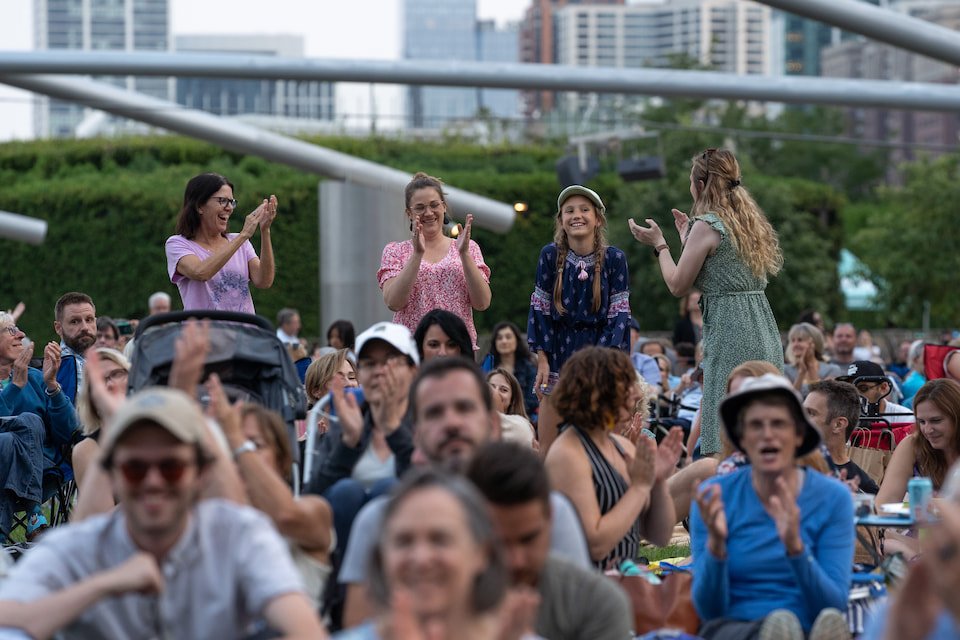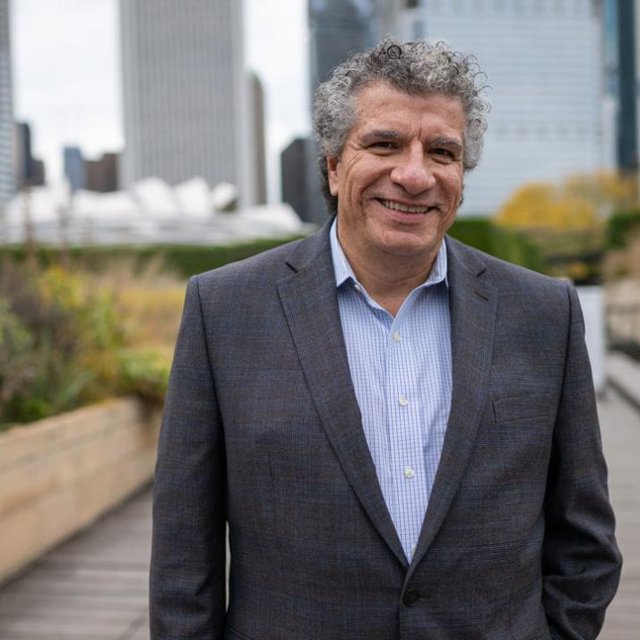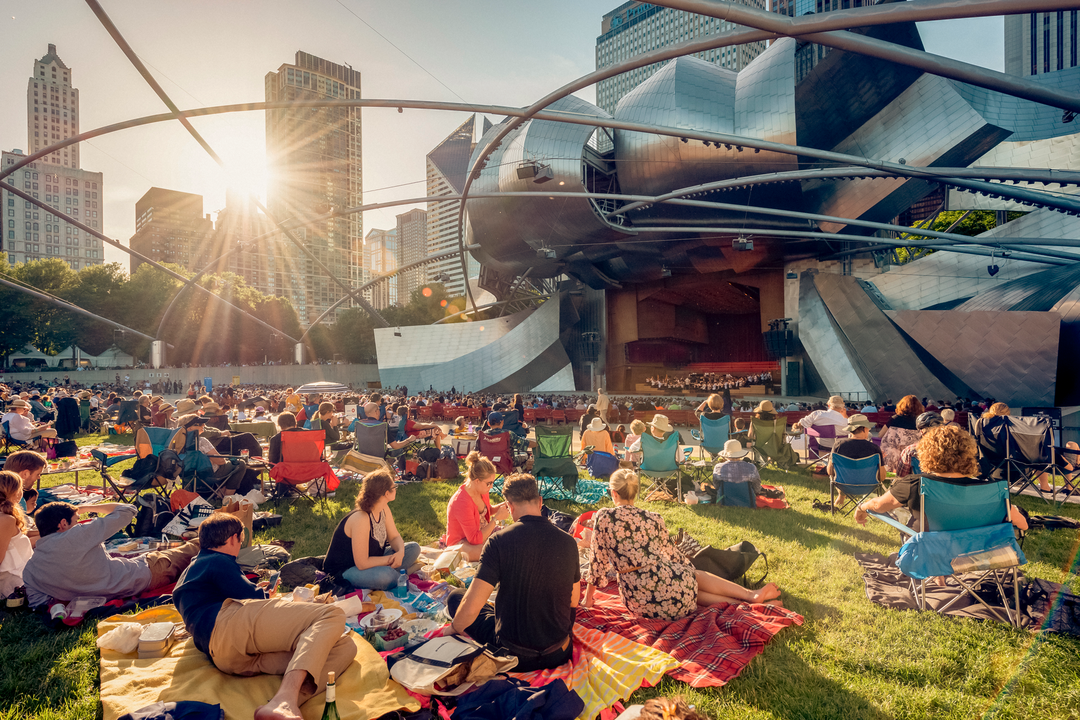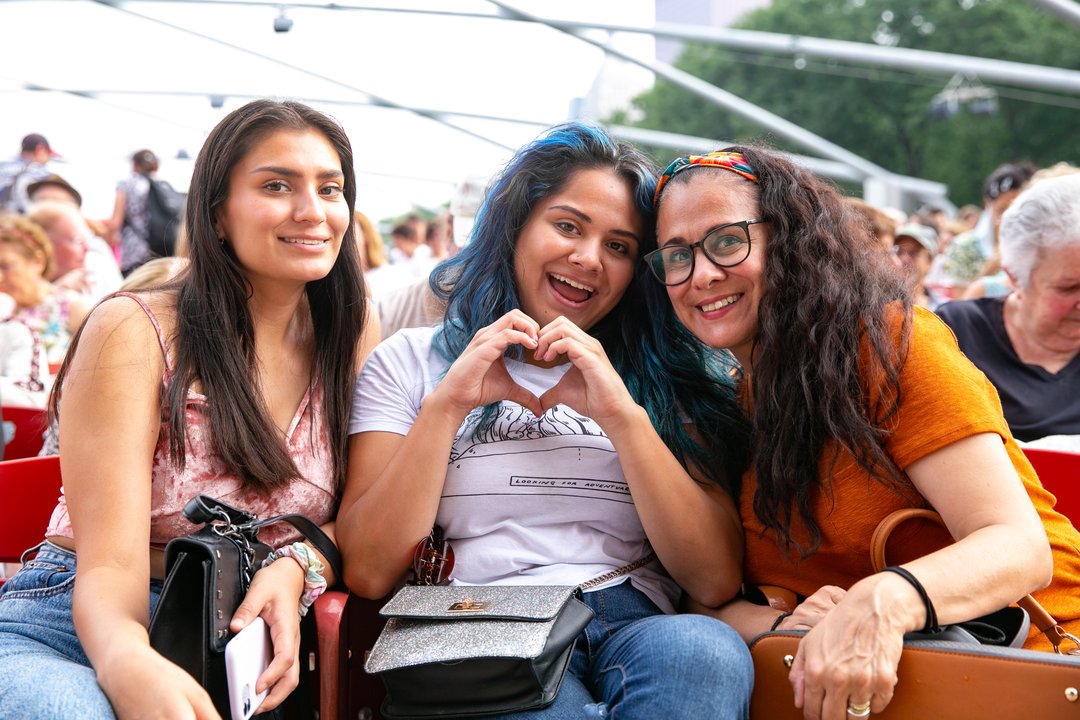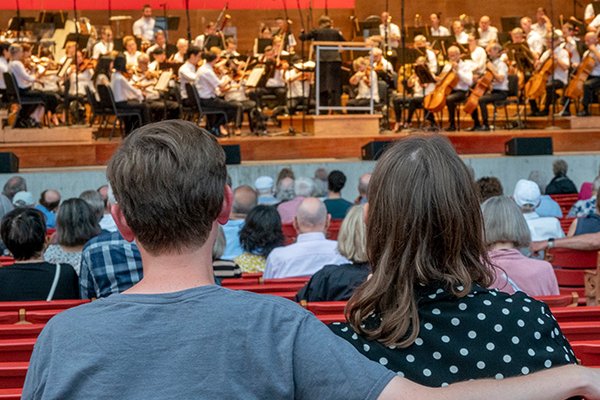
Shostakovich Symphony No. 10
Program
Augusta Read Thomas Brio (12 mins)
Richard Wagner Prelude & Liebestod from Tristan und Isolde (17 mins)
Intermission (20 mins)
Dmitri Shostakovich Symphony No. 10 (57 mins)
Moderato
Allegro
Allegretto
Andante; Allegro
Featuring
Program Notes
Augusta Read Thomas (b. 1964)
Brio (2018)
Scored for: three flutes including piccolo, three oboes including English Horn, three clarinets including bass clarinet, three bassoons including contrabassoon, four French horns, three trumpets, three trombones, tuba, timpani, percussion, harp, celesta, and strings
Performance time: 12 minutes
First Grant Park Orchestra performance
Called “a true virtuoso composer” by The New Yorker, Augusta Read Thomas is an integral figure in the contemporary music scene in Chicago. The longest-serving Mead Composer-in-Residence with the Chicago Symphony Orchestra (1997–2006), Thomas is now a professor of composition at the University of Chicago and founder/director of the Chicago Center for Contemporary Composition. Brio was commissioned by the Des Moines Symphony and Maestro Joseph Giunta as part of the orchestra’s “Music from the Heartland” project in 2018. It is dedicated to philanthropist and arts advocate Carolyn (Kay) Bucksbaum, who Thomas says embodies the energetic verve implied by the work’s title.
The musical material of Brio unfolds organically through constant harmonic, rhythmic, and textural transformation in what Thomas calls “a labyrinth of musical interrelationships and connections.” She continues, “Throughout the kaleidoscopic journey, the work passes through many lively and colorful episodes and, via an extended, gradual crescendo, reaches a full-throttle, sparkling intensity—imagine a coiled spring releasing its energy to continuously propel the musical discourse. Vivid, clangorous, brassy, and blazing, Brio culminates in music of enthusiastic, intrepid (almost Stravinsky-like) spirits while never losing its sense of dance, caprice, and effervescence.”
Richard Wagner (1813–1883)
Prelude & Liebestod from Tristan und Isolde (1857)
Scored for: three flutes including piccolo, three oboes including English Horn, three clarinets including bass clarinet, three bassoons, four French horns, three trumpets, three trombones, tuba, timpani, harp, and strings
Performance time: 17 minutes
First Grant Park Orchestra performance: July 11, 1936; Richard Czerwonky, conductor
Although Richard Wagner completed Tristan und Isolde in the summer of 1859, the opera would not be staged for another six years. Given the work’s length and difficulty and the immense financial resources required to stage it, Wagner could not find a theater to mount the opera. Finally, Wagner found a devoted fan in King Ludwig II of Bavaria, who sponsored the premiere production in Munich on June 10, 1865. To court patrons, Wagner presented the Prelude and Liebestod from Tristan und Isolde in concert in the early 1860s.
The Prelude and Liebestod mark the beginning and end of Wagner’s epic opera. Based on a 12th-century Celtic legend, Tristan und Isolde tells the story of the knight Tristan, who is tasked with bringing Irish princess Isolde to Cornwall to marry his uncle, King Marke. Tristan and Isolde unwittingly drink a love potion, resulting in a passionate love affair. King Marke happens upon them during a secret garden tryst, and Tristan is stabbed in a duel. He dies in Isolde’s arms as she sings the ecstatic Liebestod (“Love-Death”) and wills herself into oblivion as well.
The opera grew out of Wagner’s own love affair with Mathilde Wesendonck, the wife of his patron. Mathilde’s husband, Otto, had generously invited the perpetually penniless Wagner and his wife, Minna, to live in a cottage on their estate in Zurich in 1857. Each day, as Wagner worked on the libretto for Tristan und Isolde, he would bring it to the main house to read aloud to Mathilde. While it is uncertain whether they consummated their relationship, they shared an intimacy that resulted in the dissolution of his marriage and his eviction from the cottage.
This intense yearning for a forbidden love is reflected in the score’s intense chromaticism and unresolved dissonances. There is no more famous example than the so-called “Tristan chord,” which opens the Prelude and recurs at key moments in the opera. The Prelude depicts the couple’s earthly love, full of “anxious sighs, hopes and fears, laments and desires, bliss and torment,” Wagner writes. In the Liebestod comes the long-awaited resolution of the Tristan chord and the couple’s spiritual transfiguration: “As the music rises higher and higher and floods on to its magnificent climax,” Wagner explains, “Isolde is swept away on the crest of the song, past the sorrowing onlookers, to join Tristan in the vast wave of the breath of the world . . . Night and Death and Love are one.”
Dmitri Shostakovich (1906–1975)
Symphony No. 10 in E minor, op. 93 (1953)
Scored for: three flutes including piccolo, three oboes including English Horn, three clarinets including bass clarinet, three bassoons including contrabassoon, four French horns, three trumpets, three trombones, tuba, timpani, percussion, and strings
Performance time: 57 minutes
First Grant Park Orchestra performance: July 9, 1986; Christopher Lyndon-Gee, conductor
Dmitri Shostakovich wrote his Tenth Symphony after a conspicuous eight-year hiatus from the very genre that had made him famous. Shostakovich’s Ninth Symphony, written in 1945, was poorly received and was eventually banned in 1948 when the Central Committee of the Communist Party, led by Stalin watchdog Andrei Zhdanov, published a doctrine banning musical works that did not comply with the nebulous principles of “socialist realism.” The decree accused Shostakovich and many of his colleagues of “formalism” and “cosmopolitanism” (an anti-Semitic euphemism), branding him an enemy of the people.
Stalin’s death in March 1953 led to a gradual thawing of ideologically driven aesthetic constraints and a return to greater artistic freedom. Shostakovich began work on Symphony No. 10 that summer and completed it in the fall. Despite the enthusiastic reception at its premiere in Leningrad on December 17, Shostakovich’s reentry into the symphonic arena still prompted debate among his fellow composers. His symphony was the subject of three days of discussion at the Composer’s Union the following spring. The work’s lack of a program raised critics’ suspicions about its underlying meaning. Additionally, opponents found it overly seriously, insufficiently melodic, and too complex to appeal to a wide audience. Supporters, on the other hand, lauded the symphony for its mastery and innovation. For instance, composer Aram Khachaturian, who had also been implicated in Zhdanov’s 1948 decree, called it “an optimistic tragedy, infused with a firm belief in the victory of bright, life-affirming forces.”
Shostakovich publicly said there was no program associated with the Tenth Symphony, stating he only “wanted to portray human emotions and passions.” However, his potentially specious memoirs, Testimony, collected by musicologist Solomon Volkov and published posthumously in 1979, tell a slightly different story. “Shostakovich summed up Stalin’s era in the Tenth Symphony,” Volkov writes. “The second movement is inexorable, merciless, like an evil whirlwind—a ‘musical portrait’ of Stalin.” Of course, anything in Testimony must be taken with a grain of salt, as Volkov likes to paint all of Shostakovich’s works as veiled criticisms of Stalin.
The brooding first movement begins with low, quiet strings that meander in harmonic ambiguity before a lonely clarinet melody offers clarity in E minor. This clarinet theme demonstrates Mahler’s profound influence on Shostakovich, as it quotes the fourth movement of Mahler’s Second Symphony, where the mezzo-soprano soloist sings, “Der Mensch liegt in grösster Noth! Der Mensch liegt in größter Pein!” (“Man lies in direst need! Man lies in greatest pain!”). A second theme comes in the form of a nervous flute solo over plucked strings. The bassoons and contrabassoons introduce the development section, which builds into an intense triple forte. The movement ends with a single piccolo over ominous timpani rolls.
The second movement is a vicious scherzo. At just under five minutes, it proceeds with a relentless ferocity that could only be sustained over such a short movement. In contrast, the subsequent allegretto shares a scherzo-like quality but adopts a very different tone—one that is more wary than terrified. It also introduces Shostakovich’s musical monogram: “DSCH.” It comes from the German transliteration of his name (“D. Schostakowitsch”) and the German system of spelling musical notes, whereby E-flat is “S” and B-natural is “H,” forming the sequence D–E-flat–C–B. Pensive horn calls punctuate the various iterations and transformations of this musical fragment. After a melancholy Andante section, the finale’s lively Allegro brings the tragic optimism Khachaturian alluded to, ending with a final triumphant stamp of Shostakovich’s musical signature in the horns amid a flurry of string and wind activity.
—Katherine Buzard
Artistic Leadership
Support The Festival
Violin I
Jeremy Black, concertmaster
Vacant, assistant concertmaster
Trista Wong
Zulfiya Bashirova
Jennifer Cappelli
Injoo Choi
Dima Dimitrova
Erica Hudson
Hyewon Kim
Matthew Lehmann
Jayna Park
Rika Seko
Karen Sinclair
Bonnie Terry
Krzysztof Zimowski
Violin II
Liba Shacht, principal
Vacant, assistant principal
Ying Chai
Ran Cheng
Karl Davies
Likai He
Ann Lehmann
Laura Miller
Cristina Muresan
Kjersti Nostbakken
Irene Radetzky
Jeanine Wynton
Thomas Yang
Viola
Terri Van Valkinburgh, principal
Yoshihiko Nakano, assistant principal
Elizabeth Breslin
Beatrice Chen
Amy Hess
Rebecca Swan
Chloé Thominet
Cello
Walter Haman, principal
Peter Szczepanek, assistant principal
Calum Cook
Larry Glazier
Steven Houser
Eric Kutz
Eran Meir
Double Bass
Colin Corner, principal
Peter Hatch, assistant principal
Andrew Anderson
Christian Luevano
Samuel Rocklin
Chunyang Wang
Chris White
Flute
Vacant, principal
Alyce Johnson
Jennifer Lawson, assistant principal
Piccolo
Jennifer Lawson
Oboe
Mitchell Kuhn, principal
Vacant
Anne Bach, assistant principal
English Horn
Anne Bach
Clarinet
Dario Brignoli, principal
Trevor O’Riordan, assistant principal
Besnik Abrashi
Bass Clarinet
Besnik Abrashi
Bassoon
Eric Hall, principal
Nicole Haywood Vera Tenorio, assistant principal
Vacant
Contrabassoon
Vacant
Horn
Vacant, principal
Stephanie Blaha, assistant principal
Neil Kimel
Brett Hodge
Paul Clifton
Trumpet
David Gordon, principal
Mike Brozick
Vacant, assistant principal
Vacant
Trombone
Daniel Cloutier, principal
Jeremy Moeller, assistant principal
Bass Trombone
Alexander Mullins
Tuba
Andrew Smith, principal
Timpani
Daniel Karas, principal
Josh Jones, assistant principal
Percussion
Josh Jones, principal
Vacant, assistant principal
Doug Waddell
Harp
Kayo Ishimaru-Fleisher, principal
Keyboards
Christopher Guzman
Orchestra Librarian
Eliza Bangert, principal
Grant Park Chorus
* denotes leave-of-absence † 2025 Vocal Fellow
Laura Lynch Anderson
Kristina Bachrach
Madalynn Baez
Megan E. Bell
Alyssa Bennett
Tamara Bodnar
Kylie Buckham
Anna Joy Buegel
Laura Bumgardner
Katherine Buzard
Bethany Clearfield
Nathalie Colas
Carolyne DalMonte
Megan Fletcher
Kaitlin Foley
Saira Frank
Julia Frodyma
Katherine Gray-Noon
Kimberly Gunderson
Alexandra Ioan
Alexandra Kassouf
Darlene Kelsey
Olivia Knutsen
Marybeth Kurnat
Katelyn Lee
Kyuyim Lee+
Rosalind Lee
Veronica Mak
Hannah Dixon McConnell
Marie McManama
Kathleen Monson
Susan Nelson
Evangeline Ng
Máire O'Brien
Alexandra Olsavsky
Laura Perkett
Angela Presutti Korbitz
Alexia Rivera
Veronica Samiec
Emily Sinclair
Molly Snodgrass
Tiana Sorenson
Christine Steyer
Sarah van der Ploeg*
Lydia Walsh-Rock
Sherry Watkins
Emily Amesquita
Melissa Arning
Christina Bernardoni
Angela Born
Bethany Brewer
Julie DeBoer
Leah Dexter
Katrina Dubbs
Stacy Eckert
Margaret Fox
Catarine Hancock
Ruth Ginelle Heald
Sophia Heinz
Miya Higashiyama
Carla Janzen
Amy Allyssa Johnson
Kathryn Kinjo Duncan
Amanda Koopman
Anna Laurenzo
Jeannette Lee
Thereza Lituma
Chelsea Lyons
Victoria Marshall
Jessica McCarthy
Quinn Middleman
Ella Peters
Sarah Ponder
Emily Price
Stephanie Schoenhofer
Suzanne A. Shields
Marissa Simmons
Cassidy Smith
Aidan Spencer
Alannah Spencer
Margaret Stoltz
Carolyn Sundlof Boudreau
Gabrielle Timofeeva López
Elizabeth Vaughan
Corinne Wallace-Crane
A.J. Wester
Debra Wilder
Isabel Yang+
Charles Anderson
Enrico Giuseppe Bellomo
Justin Berkowitz
Madison Bolt
Hoss Brock
Steven Caldicott Wilson
Opal Clyburn-Miller+
John J. Concepción
Micah Dingler
Jared V. Esguerra
Alec Fore
Ace Gangoso
Klaus Georg
Tejas Gururaja
Paul Hunter
Garrett Johannsen
William Johnson
James Judd
Tim Lambert
Tyler Lee
Stephen D. Noon
Marcos Ochoa
Brett Potts
Nicholas Pulikowski
Peder Reiff
Samuel Rosner
Matthew W. Schlesinger
Joe Shadday
Aaron Short
Brian Skoog
Michael St. Peter
Ryan Townsend Strand
Alan Taylor*
Sean J. Watland
Nate Widelitz
Walter Aldrich
Evan Bravos
Matthew Brennan
Michael Cavalieri
Ryan J. Cox
Ed Frazier Davis
Lifan Deng
Matthew Dexter+
Chris DiMarco
Christopher Filipowicz
Dimitri German
Dominic German
David Govertsen
Spencer Greene
Brian Hupp
Jan Jarvis
Jess Koehn
Eric Miranda
Ian Morris
Ian Murrell
John E. Orduña
Wilbur Pauley
Douglas Peters
Jackson Pierzina
Martin Lowen Poock
Ian Prichard
Dan Richardson
Stephen Richardson
Benjamin D. Rivera
Scott Uddenberg
Schyler Vargas
Vince Wallace
Aaron Wardell
Ronald Watkins
Jonathon Weller
Peter Wesoloski
Jonathan Wilson
Chuck Foster
John Goodwin
Kyuyim Lee
Isabel Yang
Opal Clyburn-Miller
Matthew Dexter
